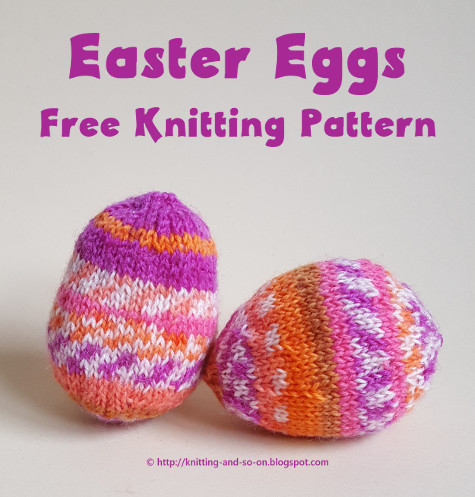A German version of this pattern is available here.
Eine deutsche Version dieser Anleitung gibt es hier.

This work by Knitting and so on is licensed under a Creative Commons Attribution-NonCommercial-ShareAlike 4.0 International License.

Materials
- about 5 grams of fingering weight yarn - I used leftovers from self-striping sock yarn
- 2.5mm dpns or circulars
- stuffing - I used (really) old yarn leftovers and waste fabric (cut into small pieces)
- a removable stitch marker to mark the end of your round
- a tapestry needle
Size
Your finished eggs will be a bit bigger than hen's eggs.
Techniques and Abbreviations
- Magic Ring CO: Basically, the magic ring technique (from crochet) is used to cast on knitted stitches. There are several videos on Youtube that show the technique - I used something similar to the technique shown in the first video, but since this is fiddly work, just use the one that suits you best.
- with knitting needles: http://youtu.be/_xZywv8wj9Y or http://youtu.be/eXgvTPSOVIw
- or with a crochet hook: http://youtu.be/4Vkpqdea-6o
Alternatively, you can always use your preferred CO and later sew the hole closed with the tail.
- [X]*Y, means, knit the sequence in brackets (X) Y times, e.g. [k2. kfb]*4 means knit the sequence "k2, kfb" four times.
Instructions
CO 8 sts and join in round - I used a Magic Ring CO (see link above). or just CO8 and join in round, if you do so, keep the tail outside of the egg, so that you can use it later to close the little hole. If you start with the Magic Ring CO, your piece will look like in illustration 1.
Round 1: k all - now your piece will look like in illustration 2.
Round 2: [kfb]*8
Round 3: k all
Round 4: [k1, kfb]*8
Round 5: k all
Round 6: k all
Round 7: [kfb, k2]*8
Round 8: k all
Round 9: k all
Round 10: [k2, kfb, k1]*8
Round 11: k all
Round 12: k all
Round 13: [k4, kfb]*8 - now your piece will look similar to illustration 3
Round 14: k all
Round 15: k all
Round 16: k all
Round 17: k all
Round 18: k all
Round 19: k all
Round 20: k all
Round 21: k all
Round 15: k all
Round 16: k all
Round 17: k all
 |
| Illustrations |
Round 18: k all
Round 19: k all
Round 20: k all
Round 21: k all
Round 22: [k6, k2tog, k4]*4
Round 23: k all
Round 24: k allRound 25: [k1, k2tog, k8]*4
Round 26: k all
Round 27: k all
Round 28: [k4, k2tog, k4]*4
Round 29: k all
Round 30: [k7, k2tog]*4
Round 31: k all
Round 32: [k1, k2tog, k1]*8
Round 33: k all
Round 34: k allStart to put stuffing into your egg. Stuffing the egg will become more difficult the smaller the upper opening gets. Now your piece will look similar to illustration 4.
Round 35: [k2tog, k1]*8
Round 36: k all
Round 37: k allRound 38: [k2tog]*8
Round 39: [k2tog]*4
Cut yarn and thread it through a tapestry needle. Make sure your egg has enough stuffing.
Catch the remaining 4 sts with the needle and pull tight. Fasten off and weave in ends.







































